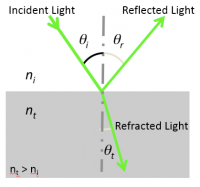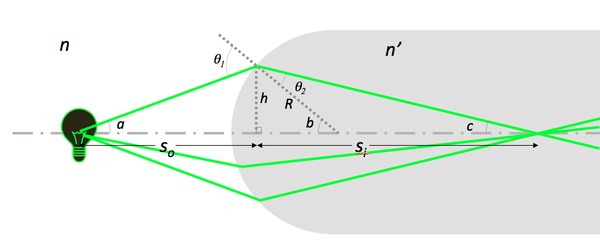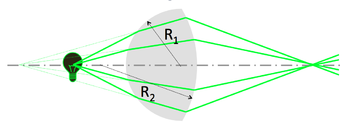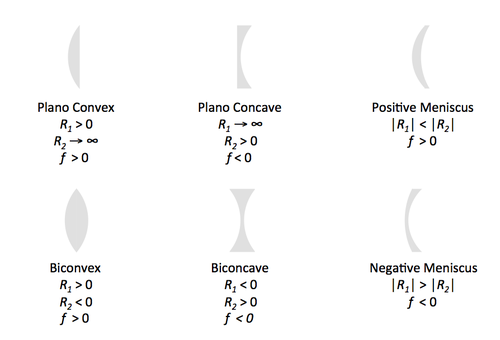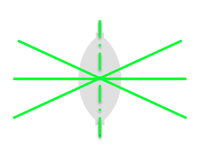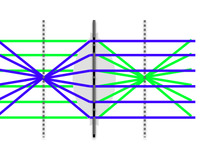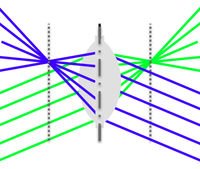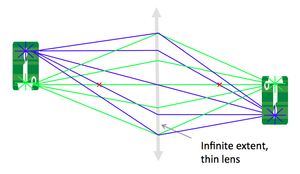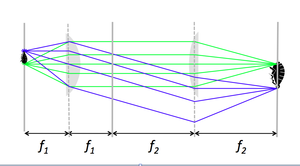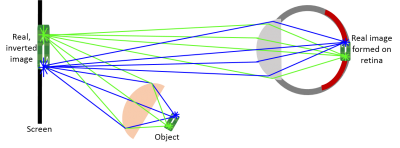Difference between revisions of "Geometrical optics and ray tracing"
From Course Wiki
MAXINE JONAS (Talk | contribs) |
MAXINE JONAS (Talk | contribs) (→Imaging with a lens) |
||
| Line 86: | Line 86: | ||
====Imaging with a lens==== | ====Imaging with a lens==== | ||
* Imagine the object is made up of many point sources. After refraction, all the rays from a single point in the object plane reach the same location in the image plane. This forms a real, inverted image. By similar triangles, magnification is equal to the ratio of distances. | * Imagine the object is made up of many point sources. After refraction, all the rays from a single point in the object plane reach the same location in the image plane. This forms a real, inverted image. By similar triangles, magnification is equal to the ratio of distances. | ||
| − | [[Image: 20.309 130819 | + | [[Image: 20.309 130819 ImagingWithLens2.png|center|thumb|300px]] |
====A ''4 f'' or compound microscope==== | ====A ''4 f'' or compound microscope==== | ||
Revision as of 20:27, 19 August 2013
Refraction and Reflection
Refraction and reflection at a boundary
- The Snell-Descartes law or law of refraction stipulates that
- $ n_i\ \sin \theta_i = n_t\ \sin \theta_t $
- with θ the angle measured from the normal of the boundary, $ n $ the refractive index (which is unitless) of the medium, the subscripts $ i $ and $ t $ referring to the incident and transmitted light, respectively.
- The law of reflection states that θi = θr
Refraction and reflection at a spherical interface
With the assumptions:
- Paraxial approximation: θ ≈ sin θ ≈ tan θ
- Thin lens approximation: $ R << S_o,\ S_i $
Snell's law predicts that
- $ n\ \sin \theta_1 = n'\ \sin \theta_2 $
- $ \sin \theta_1 \approx \sin a + \sin b \approx {h \over S_o} + {h \over R} $
- $ \sin \theta_2 \approx \sin b - \sin c \approx {h \over R} - {h \over S_i} $
- $ {n \over S_o} + {n' \over S_i} = {(n'\ - n)\over R} $
Note that
- Si does not depend on the angle $ a $.
- Light coming from a point on the filament passes through a point after refraction.
- We shall revisit these assumptions later.
| a) $ S_o > {n\ R \over (n'\ - n)}\ \Rightarrow S_i > 0 $ , | b) $ S_o = {n\ R \over (n'\ - n)}\ \Rightarrow S_i \to + \infty $, | c) $ S_o = {n\ R \over (n'\ - n)}\ \Rightarrow S_i < 0 $ |
Lenses
Lens maker formula
A simple lens consists of two spherical interfaces. Its focal length $ f $ is given by the lens maker formula:
- $ {1 \over S_o} + {1 \over S_i} = {1 \over f} = {(n'\ - n) \over n} \left ( {1 \over R_1} - {1 \over R_2} \right ) $
| Bi-convex lens | Plano-concave lens |
|---|---|
- Use the image from the first refraction as the object for the second.
- Note the sign convention for the second surface: $ R_2 $ < 0 for a convex lens, and $ (n'\ - n) $ has opposite sign.
- Concave lens: the lens maker formula holds for $ R_1 $ < 0.
Types of spherical lenses
To minimize spherical aberrations, the general rule is to position the curved side of the lens toward the collimated/straight light.
Ray Tracing
Principles
- The paraxial and thin-lens assumptions are engineering approximations that allow you to quickly and intuitively understand most optical systems using a simple set of ray tracing rules:
| Rays passing through the optical center of a lens continue in a straight line | |
| Rays traveling parallel to the optical axis pass through the focal point after refraction and vice versa | |
| Parallel rays pass through the same point in the focal plane after refraction and vice versa |
Objects and images
Imaging with a lens
- Imagine the object is made up of many point sources. After refraction, all the rays from a single point in the object plane reach the same location in the image plane. This forms a real, inverted image. By similar triangles, magnification is equal to the ratio of distances.
A 4 f or compound microscope
- A 4 f microscope is made of two positive lenses, placed at the sum of their focal lengths apart.
- An object (sample) placed in the focal plane of the first lens gets magnified by the ratio of focal lengths, $ f_2 / f_1 $.
The eye as a lens
| The eye’s optical system focuses the light from each point of the object on to a point on the retina to create an image. | |
| |
| You can also view a real image directly. In an optical system the image of a lens acts like the object of the next. | |
You can observe a virtual image.
|

